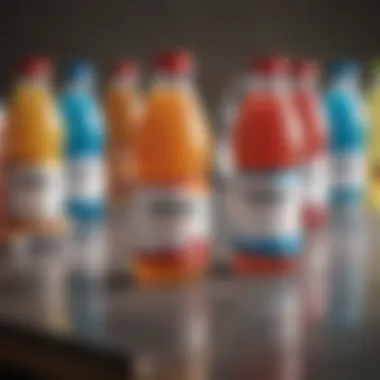Top Drinks for Replenishing Electrolytes Effectively


Intro
In the quest for optimal health and physical performance, understanding the role of electrolytes is crucial. These tiny charged particles, including sodium, potassium, chloride, and magnesium, support various bodily functions. Electrolytes help regulate hydration, muscle function, and acid-base balance. When we lose electrolytes—whether through intense exercise, heat, or illness—it can lead to symptoms like fatigue, muscle cramps, and dizziness. Thus, replenishing electrolytes is vital.
This article offers a detailed exploration of effective drinks that can help restore electrolyte balance. We will look at both natural and commercial options, evaluating their benefits and suitability for different needs. Through this analysis, readers will gain valuable insights into keeping their hydration levels optimal, leading to enhanced performance and better overall health.
Understanding Electrolytes
Electrolytes play a crucial role in maintaining various bodily functions. This section introduces the concept of electrolytes, highlighting their significance in hydration and overall health. Understanding electrolytes is important because they help balance fluids, transmit nerve signals, and contribute to muscle function. Without adequate electrolyte levels, individuals may experience symptoms like fatigue, muscle cramps, and confusion. This section breaks down what electrolytes are, the types, and their functions.
Definition and Function
Electrolytes are substances that dissolve in water to produce charged particles called ions. These ions are essential for various physiological functions. The major electrolytes include sodium, potassium, calcium, magnesium, and chloride. Each ion plays a specific role in the body. For instance, sodium manages fluid balance and blood pressure. Potassium is vital for muscle function, including the heart. Calcium not only strengthens bones but also is involved in muscle contractions and nerve communication.
These various electrolytes work together to maintain homeostasis. This balance is critical, especially during periods of physical exertion or illness when electrolyte loss can occur.
Common Types of Electrolytes
- Sodium: Sodium is significant for regulating fluid balance and blood pressure. When electrolytes are lost, as in sweating or illness, sodium needs replacement to maintain these functions effectively. Its unique ability to regulate fluid makes it a common choice in many electrolyte drinks. However, excessive sodium can lead to hypertension and other health issues.
- Potassium: Potassium is another vital electrolyte, essential for proper muscle function and cardiac health. A key characteristic of potassium is its role in signaling muscles to contract. Adequate potassium levels are crucial following exertion, making it a popular choice for athletes. Low potassium can lead to muscle weakness and cramps, which are drawbacks for people actively engaged in sports or physical activities.
- Calcium: Known for its dominance in bone health, calcium also plays roles in muscle contractions and neurotransmission. It's beneficial for overall health and recovery post-exertion. Calcium deficiency can lead to various complications, such as osteopenia or muscle spasms, which is why some electrolyte drinks emphasize calcium in their ingredients.
- Magnesium: Magnesium is less noted but is equally important. It helps with muscle function and nerve transmission and contributes to energy production. High levels of physical stress may deplete magnesium levels, so replenishment is key for optimal performance. A potential downside is that certain forms of magnesium can cause digestive issues, which may deter some individuals from consuming magnesium-rich electrolyte drinks.
- Chloride: Often overlooked, chloride works closely with sodium to maintain proper fluid balance in the body. While it does not usually appear in isolation, its presence is vital in many electrolyte solutions. Chloride also supports stomach acid production, crucial for digestive health. Its limited direct roles in popular drinks may lead to inadequate attention for chloride needs among consumers.
The Role of Electrolytes in the Body
The role of electrolytes is fundamental to various bodily processes. They regulate hydration levels, maintain acid-base balance, and enable nerve and muscle function. Without the right balance, one's performance can decline significantly. For maintained health, individuals need to understand both the significance of electrolytes and how to replenish them appropriately, especially in active lifestyles or when recovering from illness.
Signs of Electrolyte Imbalance
Recognizing the signs of electrolyte imbalance is essential for maintaining health and performance. Electrolytes are critical for numerous bodily functions, and an imbalance can lead to serious consequences. Knowing these symptoms allows individuals to take proactive measures, such as hydration and dietary adjustments, to restore balance. Proper replenishment of electrolytes is particularly relevant in scenarios involving intense activities or health issues. By identifying the signs and their implications, readers can make informed choices about their hydration strategies.
Symptoms and Their Implications
Electrolyte imbalances may manifest in a variety of symptoms, each with its implications for health. Common signs include:
- Fatigue or Weakness: A noticeable decrease in energy may signal an imbalance. This can affect daily activities and overall quality of life.
- Muscle Cramps: Sudden muscle cramps often indicate a sodium or potassium deficiency. They can be painful and may restrict physical movements.
- Dizziness: Feelings of lightheadedness can relate to decreased fluid levels, often resulting from imbalances in electrolytes like sodium.
- Heart Palpitations: Irregular heartbeats are a serious potential symptom. Electrolyte imbalances can affect heart function directly.
Being aware of these symptoms is crucial; timely recognition may prevent significant health issues down the road.
Causes of Electrolyte Loss
Various factors can lead to electrolyte loss, making it important to understand these contributors.
Exercise
Physical activity induces sweat, leading to a loss of essential electrolytes such as sodium and potassium. Endurance sports can exacerbate this issue. High-intensity exercise often requires increased electrolyte intake to avoid dehydration and maintain performance. One key characteristic of exercise-related electrolyte loss is that it can occur even in moderate conditions, making it a frequent concern for active individuals. In this context, supplements or appropriate drinks for electrolyte replacement can provide benefits. However, overconsumption of certain electrolytes may lead to additional complications.
Illness
Illnesses, particularly those involving vomiting or diarrhea, can lead to severe electrolyte depletion. The gastrointestinal tract is a significant route for electrolyte loss and hydration issues. A notable characteristic of illness-induced electrolyte loss is its unpredictability. This makes it crucial for individuals experiencing illness to monitor their hydration levels and consider replenishing electrolytes. Neglecting this can prolong recovery and weaken the immune response.
Dehydration


Dehydration is a common state that results from insufficient fluid intake. It can also occur when fluid loss exceeds intake, such as in cases of prolonged heat exposure or illness. Dehydration presents as a key risk for those engaging in strenuous activities without proper hydration. Its unique aspect is that it can escalate quickly from mild thirst to severe health risks, making regular monitoring and preventive action necessary. Staying hydrated with drinks high in electrolytes can help counteract these effects effectively.
Dietary Factors
Diet plays a crucial role in maintaining electrolyte balance. Poor nutrition can lead to deficiencies over time. A diet lacking in fruits, vegetables, and whole foods can deprive the body of vital electrolytes like potassium and magnesium. Understanding dietary influences is essential because relying solely on drinks may not be sufficient in the long run. It is beneficial to adopt a balanced diet alongside hydration strategies to ensure consistent electrolyte levels. Incorporating foods rich in potassium and magnesium can complement the efforts to achieve or maintain the necessary electrolyte balance.
Natural Sources for Electrolyte Replenishment
In the quest for optimal hydration, understanding natural sources for electrolyte replenishment plays a crucial role. Natural options not only help restore lost electrolytes but also provide broader nutritional benefits. They are typically free of artificial additives and excessive sugars, making them a preferable choice for health-conscious individuals. By consuming the right foods and drinks, one can avoid imbalances and sustain energy levels effectively.
Coconut Water
Coconut water has gained popularity for its natural electrolyte content. It stands out as a great source of potassium, sodium, and magnesium. These minerals are essential for hydration and muscle function. Coconut water is often seen as a sterial alternative to commercial sports drinks due to its lower sugar content and absence of artificial ingredients. The flavor is mild and refreshing, making it easy to consume after intense physical activity. However, it is important to choose varieties without added sugars to best reap its benefits.
Electrolyte-rich Fruits and Vegetables
Bananas
Bananas are recognized for their high potassium content. This is important because potassium is key for muscle contractions and nerve function. Eating a banana can help replenish lost minerals that occur during exercise. The natural sugars in bananas also provide a quick energy boost. They are easy to carry and require no preparation, making them a convenient snack option. However, consuming too many may lead to excessive sugar intake, so moderation is advisable.
Oranges
Oranges are rich in both potassium and Vitamin C. This citrus fruit is hydrating and provides a refreshing taste. Their juice offers a convenient way to supplement electrolytes, though whole oranges provide valuable fiber. Oranges are very popular for breakfast or as a snack. However, juicing can remove some dietary fiber, which is a consideration for those seeking balanced nutrition.
Spinach
Spinach is a leafy green packed with magnesium and calcium. These electrolytes are essential for bone and muscle health. Spinach can be enjoyed raw in salads or cooked in dishes. Additionally, it has a low calorie count, making it suitable for various dietary preferences. People may not consider spinach as a direct source of replenishment in drinks, but adding it to smoothies can effectively integrate it into a hydration routine. On the downside, the taste may not appeal to everyone.
Avocados
Avocados are another nutrient-rich source filled with potassium. This fruit is also high in healthy fats, making it satiating. Including avocado in meals can aid in maintaining balanced electrolytes. Its creamy texture lends itself well to smoothies or spreads. Avocados also help in the absorption of fat-soluble vitamins, enhancing overall health. Still, they are calorie-dense, so portion control is essential for those monitoring their weight.
Broths and Soups
Broths and soups are often overlooked as sources of electrolyte replenishment. Homemade or low-sodium varieties can provide necessary minerals like sodium and potassium. They are particularly beneficial during illness or after intense workouts. Additionally, they hydrate while being comforting and easy to digest. However, it is vital to watch out for high sodium content in commercial brands. Always check labels and consider making them at home for a healthier choice.
Commercial Electrolyte Drinks
The prevalence of electrolyte drinks in today's market reflects a growing awareness of the significance of hydration and electrolytes in athletic performance and everyday health. These drinks cater to individuals engaged in rigorous physical activities, providing quick solutions for replenishment. With various brands and formulations, a critical look at commercial options is necessary to understand their benefits and potential downsides.
Overview of Popular Brands
Numerous brands have emerged to dominate the commercial electrolyte drink market. Gatorade, Powerade, and Pedialyte are commonly recognized names. Each brand offers a range of flavors and formulations designed to aid in hydration. Gatorade, for example, has been a staple for athletes for decades due to its balance of electrolytes and carbohydrates. Powerade is known for its affordable options and extensive flavor variety. Pedialyte, originally formulated for children, is gaining popularity among adults for its effectiveness in rehydration.
Comparing Ingredients
Sugars
Sugars present in these drinks play an essential role. They provide a quick source of energy, especially during intense exercise. The presence of sugars also enhances taste, making the beverage more palatable. However, there are differing opinions on sugar consumption. While moderate sugar contributes to energy replenishment, excessive intake can lead to weight gain and other health issues. Thus, consumers should balance their sugar intake while considering their hydration choices.
Additives


Additives in commercial electrolyte drinks serve multiple purposes. They can enhance flavor and shelf-life, making the products more appealing to consumers. Some common additives include colorants and preservatives. While they may improve the sensory experience, there is ongoing debate regarding their potential health implications. Consumers are encouraged to read ingredient labels carefully to avoid unnecessary exposure to certain substances.
Artificial Flavorings
Artificial flavorings are a staple in many electrolyte drinks. They aim to provide a consistent taste experience across different batches of the product. These flavorings can make drinks more enjoyable, especially for those who might not favor the taste of natural ingredients. Nonetheless, there are concerns regarding the long-term health effects of artificial flavorings. As a result, many consumers are now leaning towards products that use natural flavorings instead, indicating a shift in preferences within the market.
Effectiveness in Replenishment
Evaluating the effectiveness of commercial electrolyte drinks involves reviewing their ability to restore fluid and essential electrolytes lost through perspiration and exertion. Scientific studies suggest that drinks formulated with an appropriate balance of sodium, potassium, and carbohydrates can significantly enhance hydration. In practice, many users report feeling revitalized and better able to perform, highlighting the essential role these beverages can play in hydration and recovery.
Choosing the right commercial electrolyte drink requires a thorough understanding of its ingredients and intended benefits. While these drinks offer convenience and effectiveness, awareness of their components will lead to more informed hydration choices.
DIY Electrolyte Drinks
In the quest for optimal hydration and electrolyte balance, DIY electrolyte drinks offer a practical and customizable solution. Creating your own drinks allows for greater control over ingredients, ensuring that you avoid unnecessary sugars and additives commonly found in commercial options. Furthermore, the flexibility in recipes means you can cater to personal preferences and dietary restrictions. This aspect can be especially empowering for individuals who are health-conscious or have specific nutritional needs.
Homemade electrolyte drinks can harness the natural electrolytes present in fruits and vegetables, while also allowing you to enhance them according to your taste. They can be particularly beneficial after physical exertion, illness, or simply as a part of your daily hydration routine.
Basic Recipe Formulations
The foundation of DIY electrolyte drinks can be simple. A basic recipe generally includes water, a source of electrolytes, and some form of sweetener or flavoring. Here’s a straightforward formulation:
- Base Liquid: Start with two cups of water. Tap water or filtered water works well, depending on your preference.
- Electrolyte Source: Add either a pinch of salt or the juice of half a lemon. Both provide essential minerals like sodium and potassium.
- Sweetener: Incorporate one to two teaspoons of honey or maple syrup for sweetness. This also adds a bit of flavor.
- Flavoring: Feel free to add some fresh mint or a handful of berries for additional taste and nutrients.
The blending of these simple ingredients yields a refreshing drink that rehydrates and replenishes. Adjust the quantities based on personal taste and dietary goals.
Customization Options
Customization options are plentiful, allowing each individual to create a drink that aligns with their preferences and nutritional strategies.
Sweeteners
The sweeteners used in DIY electrolyte drinks often define the taste and overall enjoyment of the beverage. Common choices include honey, maple syrup, or even agave syrup. These natural sweeteners are preferable to refined sugars.
Key Characteristic: Natural sweeteners typically contain some vitamins and minerals, providing added health benefits.
Beneficial Choice: Natural sweeteners can help maintain energy levels, critical for recovery post-activity.
Unique Feature: Unlike refined sugar, these sweeteners may have a lower glycemic index, which is advantageous for maintaining steady energy levels without the spikes associated with regular sugar.
Advantages/Disadvantages: While they are healthier options, one must be mindful of the caloric content, as even natural sweeteners can contribute to increased calorie intake if used excessively.
Flavor Enhancements
Flavor enhancements can significantly improve the palatability of electrolyte drinks. Ingredients such as citrus zest, ginger, or even herbs like basil can create a more enjoyable beverage.
Key Characteristic: Flavor enhancers often provide additional health benefits, such as anti-inflammatory properties found in ginger.
Beneficial Choice: Using natural flavorings boosts hydration because it encourages consumption, making it easier to drink enough fluids throughout the day.


Unique Feature: Flavor enhancers allow for creativity in recipes, turning a basic drink into something special and enjoyable.
Advantages/Disadvantages: The main downside might be that some flavor enhancers could overshadow the delicate balance of electrolytes if used excessively, but moderate amounts can significantly elevate the drink's appeal.
Additional Nutrients
Additional nutrients can elevate a basic electrolyte drink into a more comprehensive health beverage. Ingredients like chia seeds or a spoon of protein powder can be added for further benefits.
Key Characteristic: These additions can help meet protein needs or boost fiber intake depending on the ingredients used.
Beneficial Choice: Incorporating additional nutrients can improve recovery, especially after intense workouts or endurance activities.
Unique Feature: Using ingredients like chia seeds provides a rich source of omega-3 fatty acids, which can be a rare find in typical electrolyte drinks.
Advantages/Disadvantages: While they enhance nutritional value, the texture and flavor might change, which could be a downside for some individuals who prefer a smoother drink.
Experimenting with different formulations will help identify the blends that work best for individual needs and preferences.
Creating DIY electrolyte drinks can be a rewarding endeavor, promoting health and wellness both through hydration and nourishment.
Assessing the Effectiveness of Different Drinks
Understanding which drinks effectively replenish electrolytes is crucial for maintaining health and performance. As the article outlines various options, assessing their effectiveness involves examining their ingredients, hydration capacity, and how well they restore electrolyte balance. It is not sufficient to merely sip on any drink; one must consider both the composition and personal needs. Each drink may work differently depending on individual activity levels and health conditions.
Scientific Evidence and Studies
Numerous studies explore the efficacy of various electrolyte drinks. Research generally indicates that drinks formulated with specific electrolyte profiles can aid in recovery after exercise or dehydration. A study published in The Journal of Sports Medicine highlights the impact of drinks with added sodium and potassium on athletes. It demonstrates that these elements are not only crucial for hydration but also facilitate quicker recovery of muscle function post-exercise.
Moreover, research has shown that coconut water, a natural beverage, displays properties similar to commercial sports drinks. Its electrolyte content helps restore balance efficiently. However, more studies are required to gain comprehensive insights on long-term effects and the effectiveness of alternative ingredients. Conclusively, scientific evidence guides drink choices but should be viewed critically, as individual needs vary widely.
Personal Anecdotes and Experiences
Personal stories often highlight how different drinks impact hydration and recovery. For some athletes, low-sugar sports drinks like Gatorade have proven beneficial. They report quicker replenishment of energy levels, allowing them to engage in training regimens without interruption.
On the other hand, others prefer natural options like homemade electrolyte solutions combining sea salt, honey, and lemon juice. Their experience reveals more gradual but sustainable hydration without added sugars. While subjective, these experiences underline the importance of experimentation with different drinks to determine personal preference and effectiveness.
Ultimately, the method of rehydrating varies for each individual, and listening to one's body can yield the best outcomes.
By bringing together scientific research and personal anecdotes, readers can better understand how different drinks may serve their need for electrolyte replenishment. Finding the right balance between effective ingredients and personal taste is essential.
The End
The conclusion of this article reinforces the critical role electrolyte drinks play in maintaining optimal hydration and health. As discussed, electrolyte imbalances can hinder physical performance and overall well-being. The drinks considered here, both natural and commercial, are more than simple beverages; they serve as crucial allies in restoring balance when our bodies lose electrolytes.
In understanding various types of drinks, we see differences in composition, effectiveness, and flavors. Recognizing which drinks suit individual needs is vital. Some people may require quick replenishment post-exercise, while others might seek gentle hydration after mild illness.
Key Takeaways
- Electrolytes are essential for bodily functions, from muscle contraction to hydration.
- Natural sources, like coconut water and certain fruits and vegetables, provide mild alternatives to commercial drinks.
- Commercial drinks often contain added sugars and preservatives; hence, knowing the ingredient list is crucial.
- DIY options allow for personalization, catering to individual taste and dietary restrictions.
"Healthy hydration is not just about water. It's about replenishing what you lose through sweat and daily activities."
Future Considerations
Going forward, the selection of electrolyte drinks may evolve with growing health trends. More consumers are seeking products with clean labels, devoid of excessive sugars and artificial additives. This shift will likely prompt brands to reformulate their offerings.
As scientific research continues to explore optimal hydration strategies, users should remain open to new discoveries. Monitoring personal hydration needs, adapting fluid intake based on activity levels, and paying attention to how different drinks affect performance can lead to improved health outcomes. Readers are encouraged to experiment and find what resonates best with their own bodies while making educated choices.















